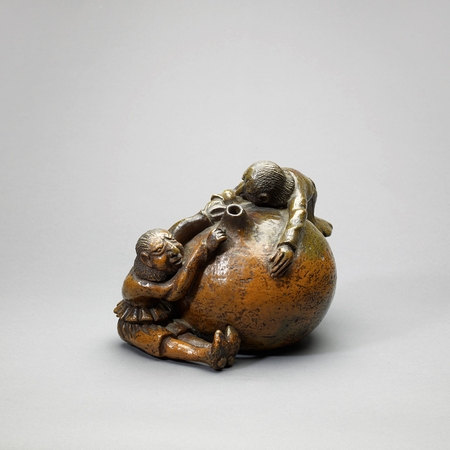Product Description
6895 Attributed to Nonko (Raku Dōnyū, 1599-1656)
A Raku pottery sake bottle with European figures
Japan 17th century Edo period
Dimensions: H. 17cm x W. 20cm (6¾” x 8″)
Hakogaki (note of authentication), inner box base reads: Meiji nijuku-nen juichigatsu korewo motomu, dairi, Rikimaru. ‘Acquired this piece, in the eleventh month, Meiji 29 (1896), representative, Rikimaru (possibly the shop name)’
Hakogaki, inner box inside lid reads: Bankoku tojin, onko no katachi ni yoru, Nonko kokoni mozou, Gengensai. ‘Europeans holding on to the hot water/liquid bottle, this (design) is replicated by Nonko. Gengensai*.’
*Gengensai: Sen Soshitsu, 11th Urasenke Tea School Master (1810-1877). He also authenticated other works by Nonko.
Hakogaki, inner box lid reads: Banjin onko no katachini yoru, tokokazari-hin. ‘Europeans holding on to a hot water/ liquid bottle, an alcove display item’.
This inscription is repeated on the outer box lid.
Exhibited:
‘Winds From Afar: Europe through the Eyes of Edo-period Kyoto’, The Museum of Kyoto, 10 March – 9 April 2000
‘Winds From Afar: Europe through the Eyes of Edo-period Kyoto’, Tobacco & Salt Museum, Tokyo, 22 April – 28 May 2000
Provenance: Saiuchi Kyushiro, Japan
This object was published in Akai Tatsuro ed., Ikoku no kaze: Edo jidai Kyoto ga mita Europa [Winds from Afar: Europe through the Eyes of Edo-period Kyoto], exhibition catalogue, (Kyoto, 2000), p. 44, no. 2-17. Text written by Yasumasa Oka, Curator at Kobe City Museum, translated from Japanese reads:
2-17: Raku alcove ornament, European figures.
Height 17.0cm, Width 20.0 cm
Edo Period
Collection of Saiuchi Kyushiro
“This is a kazarimono (display ornament) in a (globular) bag-shape which resembles a zakuro (pomegranate), two Nanban figures (‘Southern Barbarians’) are holding on to it. We do not know what precise story or myth this work is based on, but it appears to carry an auspicious meaning. The two men appear to be from Portugal, and the object’s form and subject matter are reminiscent of the earthen-ware Nanbanjin (Southern Barbarians) candle stick made by (Furuta) Oribe in the 17th century. The colour of the body has the feel of an old Red Raku ware piece, the glaze is glossy, its shape very idiosyncratic, all exemplifying a high standard of finish. Its storage box has an inscription in ink by Gengensai stating that it is a hot water/liquid container with the ‘Southern Barbarians’ holding onto it and states that it is by Nonko (Raku Dōnyū: 1599-1656)”
‘Nonko’: Raku Dōnyū, or Kichizaemon III (1599-1656) was the third generation Raku Master of the Raku family. He is also known as Nonkō, and is often considered the most skillful Raku potter. He had a close friendship with Hon’ami Kōetsu (1558-1637) whose tea bowls were fired in the Raku kiln. He introduced new styles to the wares produced in the workshop founded by Chōjirō, partly through Kōetsu’s influence. Sometimes adding the application of white or transparent glazes on top of the black glaze, or applying a glossy glaze in thick layers, he introduced a decorativeness and spontaneous individuality which was a departure from Chōjirō’s stylistic tradition of using matt black glazes.
Raku ware was started by Chōjirō, the forebear of the Raku family during the Momoyama period in the mid 16th century. Its technical roots go back to the Sancai (three colours) ware of Tang Dynasty China. During the Momoyama period colourful pottery based on this three-colour Sancai glazing came into production in and around Kyoto and Chōjirō was one of the potters who began practicing these new techniques.
It was not, however, called Raku ware when Rikyū and Chōjirō were active.
It was initially called ima-yaki, or ‘now wares’, to describe these pieces that looked avant-garde. They were subsequently renamed juraku-yaki, ‘juraku wares’, due to the fact that the Raku home was nearby the Jurakudai Palace, built by Toyotomo Hideyoshi (1537-1598), the leading warrior statesman of the time. Furthermore, the tea master Sen Rikyū who was a central figure to the birth and the promotion of Chōjirō’s tea bowls, lived inside the premises of the Palace.
‘Juraku-yaki’ was eventually abbreviated to ‘Raku-yaki’ (Raku ware). It is believed that Hideyoshi presented Chōjirō with a seal bearing the Chinese character for Raku.
Raku then became the name of the family that produced these wares.
This is the only example in the history of a family name becoming synonymous with the ceramics they produced. Although the term Raku ware at first referred only to those wares pioneered by Chōjirō together with Rikyū and produced exclusively by the Raku family, it has now become a general term used to describe a type of ceramic technique which is globally known and practiced.
Chōjirō founded Raku ware under the guidance of Sen Rikyū who redefined chanoyu (the tea ceremony). Chōjirō established a unique aesthetic in terms of the form of tea bowls, reflecting most directly the ideals of wabi (the beauty to be found in poverty and simplicity) advocated by Sen Rikyū as much as the philosophy of Zen, Buddhism and Taoism. Chōjirō, through his negation of movement, decoration and variation of form, went beyond the boundaries of individualistic expression and elevated the tea bowl into a spiritual abstraction and an intensified presence.
Works by the artist can be found in the collections of: The Raku Museum, Kyoto; The Metropolitan Museum of Art, New York.







